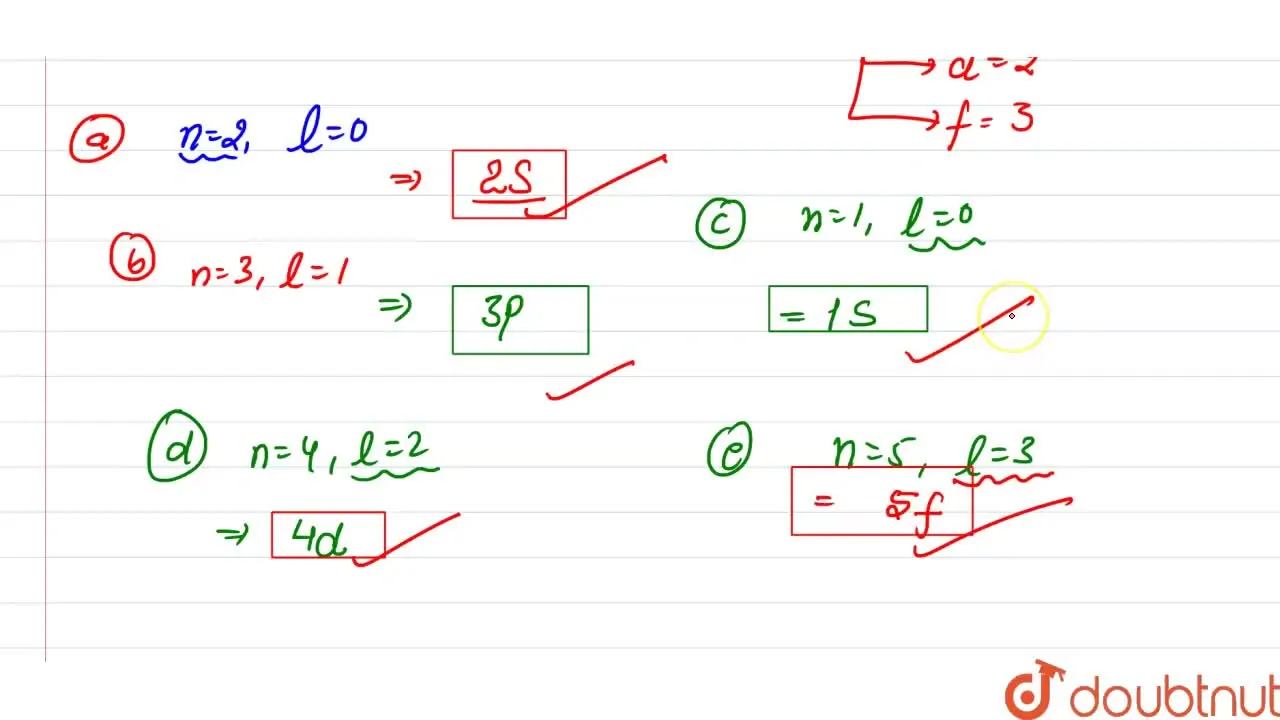s, p, d, f का प्रयोग करते हुए निम्नलिखित क्वांटम संख्याओं युक्त ओर्बिटलों को परिभाषित कीजिए।
(a) n=2, l=0 (b)n=3, l=1 (c ) n=1, l=0 (d) n=4, l=2 (e ) n=5, l=3
(a) 2s, (b) 3p, (c ) 1s, (d) 4d, (e ) 5f.
Related Playlists
- BOOK - NOOTAN HINDICHAPTER - परमाणु संरचना EXERCISE - अतिलघु उत्तरीय प्रकार के प्रश्न30videos
परमाणु संरचना
- BOOK - NOOTAN HINDICHAPTER - परमाणु संरचना EXERCISE - लघु उत्तरीय प्रकार के प्रश्न28videos
परमाणु संरचना
- BOOK - NOOTAN HINDICHAPTER - द्रव्य की अवस्थाएँ EXERCISE - एन . सी. ई . आर . टी . प्रश्न23videos
द्रव्य की अवस्थाएँ
- BOOK - NOOTAN HINDICHAPTER - पर्यावरणीय रसायन EXERCISE - एन सी आर टी प्रश्न20videos
पर्यावरणीय रसायन
Similar Questions
उस वैज्ञानिक का नाम बताइए, जिसने द्रव्य की विधुतीय प्रकृति को दर्शाया।
01:08View Solutionफैराडे के विधुत-अपघटन संबन्धी नियम लिखिए ।
02:49View Solution30∘C से . तथा 1 bar दाब पर वायु के 500dm3 आयतन को 200dm3 तक संपीडित करने के लिया कितने न्यूनतम दाब की आवश्कयता होगी ?
03:31View Solutionपर्यावरणीय रसायन शास्त्र को परिभाषित कीजिए।
01:26View SolutionUsing the s,p, d notation , deseribe the orbit with the following number
a n=1,l=0 b. n=2,l=0 c.n=3,l=3 d. n=4,l=2e. n=4,l=302:25View Solutions, p, d संकेतन द्वारा निम्नलिखित क्वांटम संख्या वाले कक्षको को बताइए-
(क) n=a,l=0
(ख) n=3,l=1
(ग) n=4,l=2
(घ) n=4,l=309:01View Solutionकारण देते हुए, बताइए की निम्नलिखित क्वांटम संख्या के कौन से मान संभव नहीं है-
(क) n=0,l=0,ml=0,ms=+1/2
(ख) n=1,l=0,ml=0,ms=−1/2
(ग) n=1,l=1,ml=0,ms=+1/2
(घ) n=2,l=1,ml=0,ms=−1/2
(ड) n=3,l=3,ml=−3,ms=+1/2
(च) n=3,l=1,ml=0,ms=+1/204:08View SolutionUsings,p,d,f notations, describe the orbital with the following quantum numbers.
(i) n=2,l=1
(ii) n=4,l=0
9iii) n=5,l=3
(iv)n=3,l=203:32View SolutionExplain, giving reasons, which of the following sets of quantum numbers are not possible. (a) n=0, l=0, m_(1)=0, m_(s)= +1//2 (b) n=1, l=0, m_(l)=0, m_(s)=-1//2 (c) n=1, l=1, m_(l)=-0, m_(s)=+1//2 (d) n=2, l=1, m_(l)=0, m_(s)=-1//2 (e) n=3, l=3, m_(l)=-3, m_(s)=+1//2(f) n=3, l=1, m_(l)=0, m_(s)=+1//2
02:49View Solutionनिम्न क्वाण्टम संख्याओं के सेट के लिए कक्षकों ( orbitals ) के नाम बताओ -
(a) n = 2,l=1,m = -1
(b ) n = 4 ,l=2,m=0
( c ) n = 3, l = 1 , m= +1
(d) n = 4 , l= 0 , m = 0
(e ) n=3, l=2, m = -205:16View Solutionनिम्न में प्रत्येक के उपकोश को प्रदर्शित करो -
(a) n=2,l=0, (b) n=4,l=2, ( c ) n=5,l=1,
(d) n=3,l=2, (e ) n=4,l=302:39View Solutionनिम्न उपकोशों को कैसे प्रदर्शित करोगे ?
(a) n = 2, l=1 (b) n =3, l = 2 (c ) n =5 , l=3, (d)n =4, l = 001:52View Solutions,p,d संकेतन द्वारा निम्नलिखित क्वांटम संख्याओं वाले कक्षकों को बताइए -
(क) n=1,l =0 (ख)n=3,l=1
(ग) n=4,l=2 (घ) n=4,l=303:25View Solutionइलेक्ट्रॉनों को जो क्वांटम संख्या n तथा l द्वारा पहचाने जाते हैं
(1) n=4,l=1 (2) n=4,l=0
(3) n=3, l =2 (4) n=3,l =102:05View SolutionExplain giving reasons , which of the following sets of quantum numbers are not possible .
a) n=0,l=0,ml=0,ms=+12
b) n=1,l=0,ml=0,ms=−12
c) n=1,l=1,ml=0,ms=+12
d) n=2,l=1,ml=0,ms=+12
e) n=3,l=3,ml=−3,ms=+12
f) n=3,l=1,ml=0,ms=+1202:40View Solution


